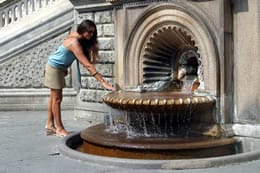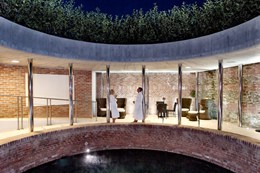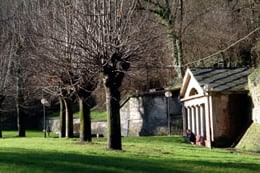Ever since it was founded by the Romans, Acqui Terme has had “water” as its dominant element, boiling hot water, extremely rich in therapeutic properties, that gushes out in the heart of the city centre, and across the Bormida river, at the foot of Monte Stregone.

THE "BOLLENTE" THERMAL SPRING
Known and used by the Thermae since Roman times, it is still today the primary source used at the Thermal treatment centres. It is a hyper thermal water, due to the high temperature it reaches when it gushes out at 75°C, with a high mineral content and a fixed residue at 180°C of 2.200 mg/litre. Due to its chemical composition it’s defined by the Marotta and Sica classifications as sulphur-bromine-iodine thermal water, with a high concentration of sulphates.
It is mainly used to treat rheumatologic, orthopaedic, otolaryngology, pulmonary, vascular and gynaecological related illnesses. Nevertheless, it is also used in dermatology and in gastroenterology, other than for beauty treatments.

THE "LAGO DELLE SORGENTI" THERMAL SPRING
There are numerous springs of thermal water that are collected into two basins, of which the largest denominates the source. Most certainly known in Roman times, they were probably used at the beginning of the 4th century thanks to the presence of the therapeutic mud deposited at the bottom of the lakes.
The water is hyper thermal even though the temperature of the main lake is around 50°C, less if compared to that of the “Bollente”, with a high mineral content of around 2.500 mg/litre, and chemically it is also classified as sulphur-bromine-iodine thermal water with a high concentration of sulphates. It has the same indications and therapeutic uses of the “Bollente”.

THE "ACQUA MARCIA" THERMAL SPRING
Discovered during the second half of the 18th century it was originally used for baths at the “Antiche Terme” thermal building, whereas in recent years its main use has been for inhalation treatments due to the high content of sulphides - H2S 38 mg/litre .
It has a minor flow compared with the other springs, and it is a cold water with a temperature of 19°C. It has a high mineral content with a fixed residue at 180°C of 2.570 mg/litre, and is classified as sulphur-bromine-iodine water. It doesn’t contain many sulphates as in relationship to the different climbing route it follows compared to the other waters, it halts in a secondary basin at 1.000 metres of depth where it looses temperature and where the sulphur-bacterium operate a reduction and transform the original sulphates in sulphides. Due to a lack of equipment, it is not frequently used for therapies, even though its high content of sulphides makes it extremely favourable for inhalation treatments, and in second place for dermatology treatments.
Questo contenuto è disponibile in:


